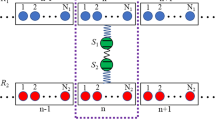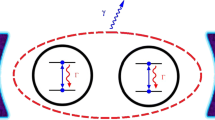Abstract
By means of collision models, we study the effects of system–environment correlations (SECs) on the heat transport and quantum entanglement in both transient and steady-state regimes. In the considered models, the reservoirs are simulated through two chains of particles whose nearest-neighbor collisions induce the SECs. In the first model, the system is a qubit connecting two independent reservoirs with different temperatures. We show that the heat currents exhibit oscillations and even reversed flows from the cold reservoir to the hot one depending on intracollision strengths of reservoir particles. In the stationary regime, we observe a nonlinear relation between heat currents and intracollision strengths, which can be accounted for by the established steady-state SECs. In our second model, the system contains two interacting qubits and we show that the initial entanglement of the system either vanishes within finite steps of collisions or recovers from disappearing and retains nonzero value. The combined regions of relevant parameters that sustain steady-state entanglement are presented. We also present a method to enhance the steady-state entanglement by enlarging temperature differences of the two reservoirs.








Similar content being viewed by others
References
Gemma, G., Michel, M., Mahler, G.: Quantum Thermodynamics. Springer, New York (2004)
Uzdin, R., Levy, A., Kosloff, R.: Equivalence of quantum heat machines, and quantum-thermodynamic signatures. Phys. Rev. X 5, 031044 (2015)
Goold, J., Huber, M., Riera, A., del Rio, L., Skrzypczyk, P.: The role of quantum information in thermodynamics-a topical review. J. Phys. A Math. Theor. 49, 143001 (2016)
Vinjanampathy, S., Anders, J.: Quantum thermodynamics. Contemp. Phys. 57, 545 (2016)
Allahverdyan, A.E., Nieuwenhuizen, T.M.: Extraction of work from a single thermal bath in the quantum regime. Phys. Rev. Lett. 85, 1799 (2000)
Kieu, T.D.: The second law, maxwell’s demon, and work derivable from quantum heat engines. Phys. Rev. Lett. 93, 140403 (2004)
Leggio, B., Bellomo, B., Antezza, M.: Quantum thermal machines with single nonequilibrium environments. Phys. Rev. A 91, 012117 (2015)
Malabarba, A.S.L., Short, A.J., Kammerlander, P.: Clockdriven quantum thermal engines. New J. Phys. 17, 045027 (2015)
Alicki, R., Gelbwaser-Klimovsky, D.: Non-equilibrium quantum heat machines. New J. Phys. 17, 115012 (2015)
Tonner, F., Mahler, G.: Autonomous quantum thermodynamic machines. Phys. Rev. E 72, 066118 (2005)
Henrich, M.J., Mahler, G., Michel, M.: Driven spin systems as quantum thermodynamic machines: fundamental limits. Phys. Rev. E 75, 051118 (2007)
Azimi, M., Chotorlishvili, L., Mishra, S.K., Vekua, T., Hubner, W., Berakdar, J.: Quantum otto heat engine based on a multiferroic chain working substance. New J. Phys. 16, 063018 (2014)
Leggio, B., Antezza, M.: Otto engine beyond its standard quantum limit. Phys. Rev. E 93, 022122 (2016)
Quan, H.T., Liu, Y.X., Sun, C.P., Nori, F.: Quantum thermodynamic cycles and quantum heat engines. Phys. Rev. E 76, 031105 (2007)
Zagoskin, A.M., Savelev, S., Nori, F., Kusmartsev, F.V.: Squeezing as the source of inefficiency in the quantum otto cycle. Phys. Rev. B 86, 014501 (2012)
Linden, N., Popescu, S., Skrzypczyk, P.: How small can thermal machines be? The smallest possible refrigerator. Phys. Rev. Lett. 105, 130401 (2010)
Correa, L.A., Palao, J.P., Adesso, G., Alonso, D.: Performance bound for quantum absorption refrigerators. Phys. Rev. E 87, 042131 (2013)
Brunner, N., Huber, M., Linden, N., Popescu, S., Silva, R., Skrzypczyk, P.: Entanglement enhances cooling in microscopic quantum refrigerators. Phys. Rev. E 89, 032115 (2014)
Kosloff, R., Geva, E., Gordon, J.M.: Quantum refrigerators in quest of the absolute zero. J. Appl. Phys. 87, 8093 (2000)
Brask, J.B., Brunner, N.: Small quantum absorption refrigerator in the transient regime: time scales, enhanced cooling, and entanglement. Phys. Rev. E 92, 062101 (2015)
Silva, R., Skrzypczyk, P., Brunner, N.: Small quantum absorption refrigerator with reversed couplings. Phys. Rev. E 92, 012136 (2015)
Yu, C.S., Zhu, Q.Y.: Re-examining the self-contained quantum refrigerator in the strong-coupling regime. Phys. Rev. E 90, 052142 (2014)
Man, Z.X., Xia, Y.J.: Smallest quantum thermal machine: the effect of strong coupling and distributed thermal tasks. Phys. Rev. E 96, 012122 (2017)
He, Z.C., Huang, X.Y., Yu, C.S.: Enabling the self-contained refrigerator to work beyond its limits by filtering the reservoirs. Phys. Rev. E 96, 052126 (2017)
Wichterich, H., Henrich, M.J., Breuer, H.P., Gemmer, J., Michel, M.: Modeling heat transport through completely positive maps. Phys. Rev. E 76, 031115 (2007)
Nicacio, F., Ferraro, A., Imparato, A., Paternostro, M., Semiao, F.L.: Thermal transport in out-of-equilibrium quantum harmonic chains. Phys. Rev. E 91, 042116 (2015)
Oviedo-Casado, S., Prior, J., Chin, A.W., Rosenbach, R., Huelga, S.F., Plenio, M.B.: Phase-dependent exciton transport and energy harvesting from thermal environments. Phys. Rev. A 93, 02010 (2016)
Werlang, T., Marchiori, M.A., Cornelio, M.F., Valente, D.: Optimal rectification in the ultrastrong coupling regime. Phys. Rev. E 89, 062109 (2014)
Ordonez-Miranda, J., Ezzahri, Y., Joulain, K.: Quantum thermal diode based on two interacting spinlike systems under different excitations. Phys. Rev. E 95, 022128 (2017)
Werlang, T., Valente, D.: Heat transport between two pure-dephasing reservoirs. Phys. Rev. E 91, 012143 (2015)
Man, Z.X., An, N.B., Xia, Y.J.: Controlling heat flows among three reservoirs asymmetrically coupled to two two-level systems. Phys. Rev. E 94, 042135 (2016)
Rau, J.: Relaxation phenomena in spin and harmonic oscillator systems. Phys. Rev. 129, 1880 (1963)
Scarani, V., Ziman, M., Stelmachovic, P., Gisin, N., Buzek, V.: Thermalizing quantum machines: dissipation and entanglement. Phys. Rev. Lett. 88, 097905 (2002)
Ziman, M., Stelmachovic, P., Buzek, V., Hillery, M., Scarani, V., Gisin, N.: Diluting quantum information: an analysis of information transfer in system–reservoir interactions. Phys. Rev. A 65, 042105 (2002)
Ciccarello, F., Palma, G.M., Giovannetti, V.: Collisionmodel-based approach to non-markovian quantum dynamics. Phys. Rev. A 87, 040103 (2013)
Kretschmer, S., Luoma, K., Strunz, W.T.: Collision model for non-markovian quantum dynamics. Phys. Rev. A 94, 012106 (2016)
Cakmak, B., Pezzutto, M., Paternostro, M., Mustecaplioglu, O.E.: Non-Markovianity, coherence, and system–environment correlations in a long-range collision model. Phys. Rev. A 96, 022109 (2017)
Lorenzo, S., Ciccarello, F., Palma, G.M.: Composite quantum collision models. Phys. Rev. A 96, 032107 (2017)
Filippov, S.N., Piilo, J., Maniscalco, S., Ziman, M.: Divisibility of quantum dynamical maps and collision models. Phys. Rev. A 96, 032111 (2017)
McCloskey, R., Paternostro, M.: Non-Markovianity and system-environment correlations in a microscopic collision model. Phys. Rev. A 89, 052120 (2014)
Bernardes, N.K., Carvalho, A.R.R., Monken, C.H., Santos, M.F.: Environmental correlations and Markovian to non-Markovian transitions in collisional model. Phys. Rev. A 90, 032111 (2014)
Jin, J., Yu, C.S.: Non-markovianity in the collision model with environmental block. New J. Phys. 20, 053026 (2018)
Jin, J., Giovannetti, V., Fazio, R., Sciarrino, F., Mataloni, P., Crespi, A., Osellame, R.: All-optical non-Markovian stroboscopic quantum simulator. Phys. Rev. A 91, 012122 (2015)
Cuevas, Á., Geraldi, A., Liorni, C., Diego Bonavena, L., De Pasquale, A., Sciarrino, F., Giovannetti, V., Mataloni, P.: All optical implementation of collision-based evolutions of open quantum systems (2018). arXiv:1809.01922 [quant-ph]
Man, Z.X., Xia, Y.J., Franco, R.L.: Temperature effects on quantum non-Markovianity via collision models. Phys. Rev. A 97, 062104 (2015)
Lorenzo, S., McCloskey, R., Ciccarello, F., Paternostro, M., Palma, G.M.: Landauer’s principle in multipartite open quantum system dynamics. Phys. Rev. Lett. 115, 120403 (2015)
Lorenzo, S., Farace, A., Ciccarello, F., Palma, G.M., Giovannetti, V.: Heat flux and quantum correlations in dissipative cascaded systems. Phys. Rev. A 91, 022121 (2015)
Pezzutto, M., Paternostro, M., Omar, Y.: Implications of non-markovian quantum dynamics for the landauer bound. New J. Phys. 18, 123018 (2016)
Li, L., Zou, J., Li, H., Xu, B.M., Wang, Y.M., Shao, B.: Effect of coherence of nonthermal reservoirs on heat transport in a microscopic collision model. Phys. Rev. E 97, 022111 (2018)
Chiara, G.D., Landi, G., Hewgill, A., Reid, B., Ferraro, A., Roncaglia, A.J., Antezza, M.: Reconciliation of quantum local master equations with thermodynamics. New J. Phys. 20, 113024 (2018)
Watanabe, S.: Information theoretical Analysis of Multivariate Correlation. IBM J. Res. Dev. 4, 66 (1960)
Kumar, A.: Multiparty quantum mutual information: an alternative definition. Phys. Rev. A 96, 012332 (2017)
Hu, M.L., Fan, H.: Quantum coherence of multiqubit states in correlated noisy channels (2018). arXiv:1812.04385v1 [quant-ph]
Nielsen, M.A., Chuang, I.L.: Quantum Computation and Quantum Information. Cambridge University Press, Cambridge (2007)
Arnesen, M.C., Bose, S., Vedral, V.: Natural thermal and magnetic entanglement in the 1D heisenberg model. Phys. Rev. Lett. 87, 017901 (2001)
Wang, X.G.: Entanglement in the quantum heisenberg XY model. Phys. Rev. A 64, 012313 (2001)
Gunlycke, D., Kendon, V.M., Vedral, V., Bose, S.: Thermal concurrence mixing in a one-dimensional ising model. Phys. Rev. A 64, 042302 (2001)
Eisler, V., Zimboras, Z.: Entanglement in the XX spin chain with an energy current. Phys. Rev. A 71, 042318 (2005)
Quiroga, L., Rodrguez, F.J., Ramrez, M.E., Pars, R.: Nonequilibrium thermal entanglement. Phys. Rev. A 75, 032308 (2007)
Sinaysky, I., Petruccione, F., Burgarth, D.: Dynamics of nonequilibrium thermal entanglement. Phys. Rev. A 78, 062301 (2008)
Huang, X.L., Guo, J.L., Yi, X.X.: Nonequilibrium thermal entanglement in a three-qubit XX model. Phys. Rev. A 80, 054301 (2009)
Brask, J.B., Haack, G., Brunner, N., Huber, M.: Autonomous quantum thermal machine for generating steady-state entanglement. New J. Phys. 17, 113029 (2015)
Wootters, W.K.: Entanglement of formation of an arbitrary state of two qubits. Phys. Rev. Lett. 80, 2245 (1998)
Acknowledgements
This work is supported by National Natural Science Foundation (China) under Grant Nos. 11574178 and 61675115, Shandong Provincial Natural Science Foundation (China) under Grant No. ZR2016JL005, and Taishan Scholar Project of Shandong Province (China) under Grant No. tsqn201812059.
Author information
Authors and Affiliations
Corresponding author
Additional information
Publisher's Note
Springer Nature remains neutral with regard to jurisdictional claims in published maps and institutional affiliations.
Appendix
Appendix
In this appendix, we present some explanations for the derivation of the steady-state as well as Eqs. (14)–(16) in the first model. We first assume a general form of the steady-state \(\widetilde{\rho }_{R^{(h)}_{m}SR^{(c)}_{m}}\) with matrix elements \(\widetilde{\rho }_{kl}\equiv \left\langle \overline{k} \left| \widetilde{\rho }_{R^{(h)}_{m}SR^{(c)}_{m}}\right| \overline{l}\right\rangle \) (\(k,l=1,2,\ldots ,8\)) expressed in the ordered basis \(\{\left| \overline{1}\right\rangle =\left| 000\right\rangle , \left| \overline{2}\right\rangle =\left| 001\right\rangle , \left| \overline{3}\right\rangle =\left| 010\right\rangle ,\) \(\left| \overline{4}\right\rangle =\left| 011\right\rangle , \left| \overline{5}\right\rangle =\left| 100\right\rangle , \left| \overline{6}\right\rangle =\left| 101\right\rangle , \left| \overline{7}\right\rangle =\left| 110\right\rangle , \left| \overline{8}\right\rangle =\left| 111\right\rangle \}\) of \(R_{m}^{(h)}\), S, and \(R_{m}^{(c)}\). To derive the concrete form of the steady state, we should construct and solve 64 equations for these elements. Since the total systems of \(R_{m}^{(h)}\), S, and \(R_{m}^{(c)}\) have reached the stationary regime, their state \(\widetilde{\rho }_{R^{(h)}_{m}SR^{(c)}_{m}}\) should remain invariant under the successive collisions of \(S-R_{m}^{(h)}\), \(S-R_{m}^{(c)}\), \(R_{m}^{(h)}-R_{m+1}^{(h)}\), and \(R_{m}^{(c)}-R_{m+1}^{(c)}\) as given in Eqs. (11) and (12). Suppose the overall action of these collisions is \(F(J_{h},J_{c},\varOmega )\), then we have \(\widetilde{\rho }_{R^{(h)}_{m}SR^{(c)}_{m}}=F(J_{h},J_{c},\varOmega )\widetilde{\rho }_{R^{(h)}_{m}SR^{(c)}_{m}}F^{\dag }(J_{h},J_{c},\varOmega )\), from which we can derive the 64 equations for the elements \(\widetilde{\rho }_{kl}\) and obtain their values via numerical calculations.
From the definition of heat current (13), we know that to calculate the released heat \(\Delta \widetilde{Q}_{m}^{(h)}\) of the hot reservoir we should first derive the state \(\widetilde{\rho ^{\prime }}_{R_{m}^{(h)}}\), i.e., the state of \(R_{m}^{(h)}\) after collision with the system, as well as \(\widetilde{\rho }_{R_{m}^{(h)}}\). Since we have assumed the general form of the steady-state \(\widetilde{\rho }_{R^{(h)}_{m}SR^{(c)}_{m}}\), \(\widetilde{\rho }_{R_{m}^{(h)}}\) can be obtained straightforward by tracing \(\widetilde{\rho }_{R^{(h)}_{m}SR^{(c)}_{m}}\) over the degrees of freedom of S and \(R^{(c)}_{m}\) and expressed in terms of the matrix elements \(\widetilde{\rho }_{kl}\). Suppose the collision between S and \(R^{(h)}_{m}\) is given by the action \(f(J_{h})\), then we shall obtain \(\widetilde{\rho }^{\prime }_{R_{m}^{(h)}}\) through tracing the transformed state \(f(J_{h})\widetilde{\rho }_{R^{(h)}_{m}SR^{(c)}_{m}}f^{\dag }(J_{h})\) over the degrees of freedom of S and \(R^{(c)}_{m}\). The form of \(\widetilde{\rho }^{\prime }_{R_{m}^{(h)}}\) can thus be expressed by the matrix elements \(\widetilde{\rho }_{kl}\) and \(J_{h}\). In the total expression of \(\Delta \widetilde{Q}_{m}^{(h)}\), we can easily find the terms contributed by the diagonal and off-diagonal elements of \(\widetilde{\rho }_{kl}\). Therefore, we divide \(\Delta \widetilde{Q}_{m}^{(h)}\) correspondingly into two parts as given in Eqs. (15) and (16).
Rights and permissions
About this article
Cite this article
Man, ZX., Zhang, Q. & Xia, YJ. The effects of system–environment correlations on heat transport and quantum entanglement via collision models. Quantum Inf Process 18, 157 (2019). https://doi.org/10.1007/s11128-019-2275-9
Received:
Accepted:
Published:
DOI: https://doi.org/10.1007/s11128-019-2275-9




